The Ultimate Hummus Showdown
by Tori Finkle
If someone were to construct a food pyramid of my diet, hummus would definitely be one of its foundational layers. I’ve dutifully carted a hummus and cheese sandwich to work for nearly four years. I get the hummus plate from the local Greek place when my office orders out. Why branch out from something so versatile, filling and widely accessible?
There’s just one nagging problem I haven’t been able to dispel: Could I be doing this cheaper? And, more importantly, would a DIY approach to hummus be worth the time and effort?
This past weekend I finally decided to find out, orchestrating what I’ve been calling the Ultimate Hummus Showdown. I whipped up five recipes and invited a few folks over to rate them, with the hopes of determining whether I can get a leg up on the hummus industrial complex. I also threw in my go-to, store-bought hummus for comparison purposes.
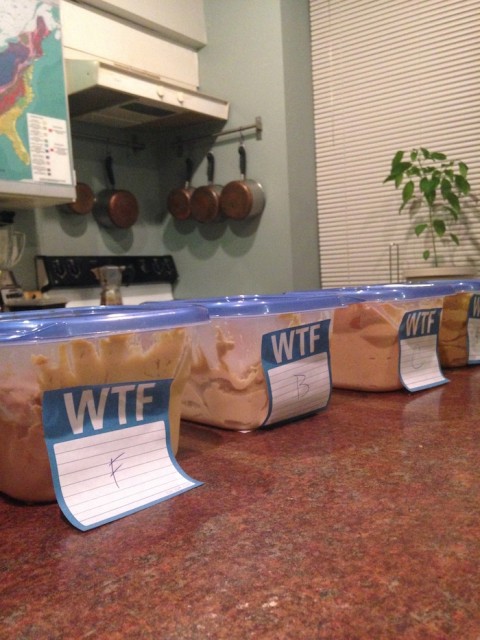
Awaiting judgment.
Below are my findings, which I hope prove useful to you, my fellow garbanzo lovers:
The Cheapskate
Average group score (out of 5): 2.4
Prep time: 10 minutes
Approximate cost per cup: $1.31
My first shot at hummus was not unlike my previous attempts: quick and dirty. Can of beans, some tahini, the most basic flavor additions and into the food processor it goes. Bingo, bango, let’s get cooking!
This recipe from Real Simple most closely resembles the vast majority of hummus recipes I’ve found over the years, and I get seduced every time into thinking I can make fancy, delicious hummus with practically no time, effort or cost.
I figured this would help set the baseline for the experiment, and didn’t expect that it would be highly reviewed. Frankly, it wasn’t much of a conversation piece during the taste trials.

The Health Nut
Group score: 2.7
Prep time: 15 minutes
Cost per cup: $1.66
During my recipe searches, I came across a hummus shortcut just crazy enough to try: adding yogurt instead of oil and tahini. It cuts calories and ups protein content, which is great if you, for example, sometimes find yourself scooping an entire serving of hummus onto a single pita chip (*cough*).
The instructions are straightforward — on par with the cheapskate model. Still, the author of this recipe on About.com got a little aggressive on the timing, claiming that the dish required zero minutes to prepare. It didn’t quite meet that standard, but I was nonetheless happy with the pace.
I found it decently flavorful and liked the creamy texture the yogurt provided. Another judge rated it with “a high ‘yum’ factor.” But the truth is that most people weren’t nuts about this one; some even called it “watery.” Hummus haters gonna hate.

The Classic
Group score: 3.0
Prep time: 45 minutes
Cost per cup: $2.00
The next recipe I tried, from Food52, I thought of as the straight pitch down the middle. It’s another classic recipe, only this time with cooked chickpeas instead of canned beans, which are supposed to offer a creamier texture and stronger flavor. Dried beans are considerably cheaper than the canned kind, but this recipe requires a whole cup of tahini — the single most hummus expensive ingredient.
Boiling the beans was not a technically challenging exercise, but I was surprised at how much I had to watch the pot to keep it from bubbling over. The recipe calls for cooking the beans in baking soda for a couple minutes first, which I bet added to the fizz factor.
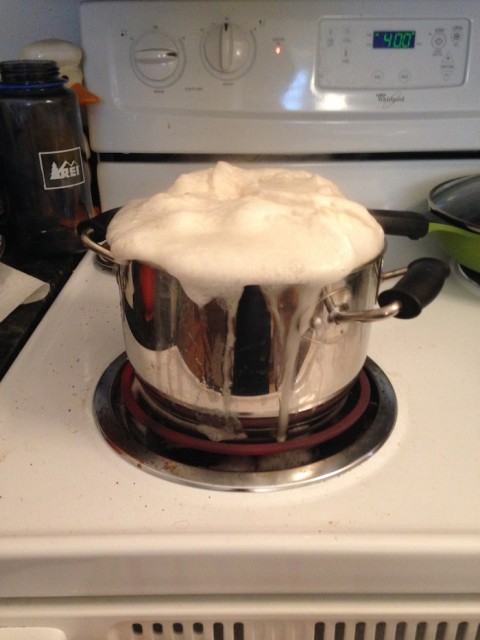
Double, double, toil and trouble
This recipe disappointed, though perhaps that’s my fault. It whipped up creamy in my food processor, but took on a much denser quality when refrigerated. Even after sitting on the counter for a couple of hours, it was the most difficult to fish out of the bowl — a party foul, for sure.
Still, several people responded well to the flavor, particularly the hints of garlic.

The Wild Card
Group score: 3.5
Prep time: 35 minutes
Cost per cup: $1.41
I’m a hummus purist, but my previous attempts at making it have turned out so boring that I wanted to throw in at least one entry that would be guaranteed to overwhelm my subjects’ taste buds.
Enter: Indian-inspired hummus. This Food Network recipe involves sautéing an onion with curry powder, which then gets thrown in with canned beans and the rest of the ingredients in the processor.
It had a zesty bite … perhaps because I sort of accidentally quadrupled the amount of cayenne called for in the recipe. Two commenters noted — Doge style — that it was “very curry.” Indeed. Much yellow. So spices.

The Cadillac
Group score: 3.8
Prep time: 80 minutes
Cost per cup: $2.64
Finally, I went all-out. I started with Smitten Kitchen’s popular “ethereally smooth hummus” recipe, upping the ante even further with fresh roasted red pepper. I also roasted the garlic for this one, instead of using raw. Showstopper hummus!
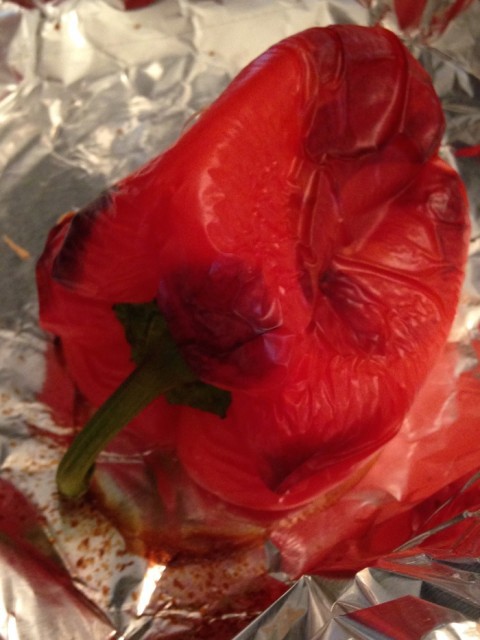
Bell pepper roasted with care.
The recipe also calls for cooked chickpeas and takes that process one step further by imploring the reader to peel the skins off the beans to ensure even greater creaminess.
The baking soda simmer process had already pulled the skins off most of the beans, but I think I overcooked the chickpeas just slightly, giving many of them a mushy texture that made extracting the skins much harder. It was a sloppy mess. If you don’t have grapes lying around next Halloween, overcooked chickpeas would make a great stand-in for the “bowl of eyeballs” at your haunted house. And it took me 30 minutes to peel through a three-cup batch. (Smitten Kitchen’s cheerful Deb Perelman said it only took her nine.) Let’s just say I will probably never peel chickpea skins again — not for all the hummus high-fives in the world.
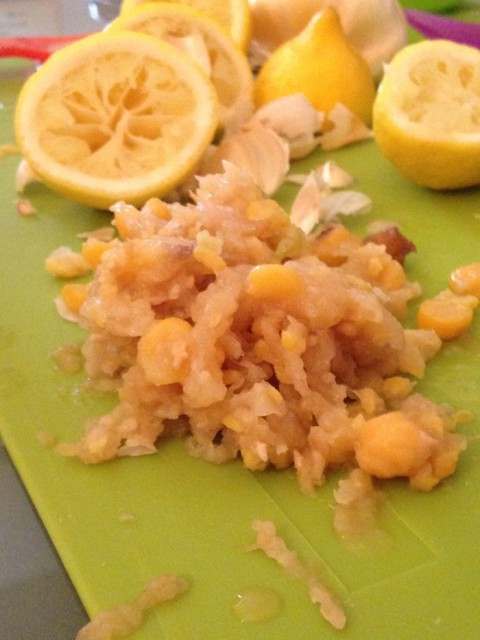
Chickpea skin pile, ewww.
Still, the results were fairly positive — the Cadillac was “delicious and peppery.” And I hate to admit it, but the dish did have a standout texture.
Given the time investment and ultimate cost of this hummus, it’s an open question whether the recipe is worth repeating. Certainly this isn’t something I’d undertake on a weekly basis. As one tester noted, “it really is like a Cadillac — expensive, over the top and not worth the money.”

The Placebo
Group score: 4.1
Prep time: negligible, if you’re already at the store
Cost per cup: $3.99 ($2.75 for the party size)
For a baseline, I picked up my choice hummus at Whole Foods, Asmar’s brand in the original flavor, and transferred it to a Tupperware container to match the rest. It’s fluffy and light, and is almost a little sweet, with a nice balance of flavors.
The group responded very well to this one, with one enthusiastic taster summing it up as “bomb ass hummus.”
Now, I’ll admit that my heart shattered into a tiny million pieces when I realized that the scales were tipping so strongly in the store-bought direction. After a full day slaving away in the kitchen, I had come to see all the homemade dishes as my babies — even the slow-witted, runty cheapskate hummus. I guess it’s human nature to value things that take effort; it’s an intangible to consider.
That said, after mentally resuming my role as chief hummus investigator, I realized those jerks were right. The Asmar’s did taste better, albeit at a cost.

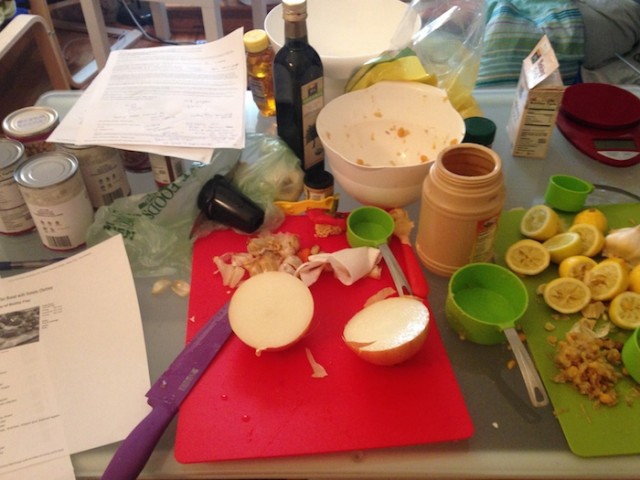
The carnage.
Lessons Learned
So yes, I confess that the store-bought hummus won the day on the taste front. Then again, it was by far the saltiest hummus of the bunch.
The top complaint across the board was that I failed to add enough salt to my creations, especially when compared to the store-bought kind. As a novice cook, I live in fear of over-salting and held back on that account. By comparison, Asmar’s has 5% of your daily value of sodium in a two-tablespoon serving. Yikes!
I also realized that hummus preferences vary quite a bit. Each hummus got both low and high marks, with many getting scores along the full one-to-five point spectrum. There wasn’t much consensus except that the store-bought kind was pretty tasty. But even that had a strong dissent from one person who thought it was bland and too salty. Perhaps there is no Platonic ideal for hummus?
On the other hand, the scattered votes suggest that most hummus is probably adequate — none of the dishes turned out inedible, after all.
If you have the time and you’re looking to save some scratch, taking a chance on DIY hummus might still be the way to go. Just be warned that there could be some experimenting involved. Perhaps hummus is a journey, not a destination.
Tori lives and eats in D.C., where she writes about Congress.
Support The Billfold
The Billfold continues to exist thanks to support from our readers. Help us continue to do our work by making a monthly pledge on Patreon or a one-time-only contribution through PayPal.
Comments